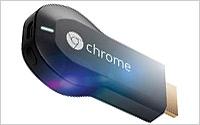Commentary
How Chromecast Will Support Cross-Channel Marketing
- by Laurie Sullivan , Staff Writer @lauriesullivan, July 25, 2013
 Rather than
a revolution, I call Google Chromecast an evolution of products the tech industry will continue to see in the near future. It even helps search marketers reach consumers more often through
cross-channel media and devices. Here's how.
Rather than
a revolution, I call Google Chromecast an evolution of products the tech industry will continue to see in the near future. It even helps search marketers reach consumers more often through
cross-channel media and devices. Here's how.
When I purchased the first version of the Sony Google TV years ago, I asked the Best Buy salesperson when Google would offer a gadget that
fits into the TV's HDMI port allowing consumers to stream content from smartphones, tablets and traditional computers in the house.
While the cost for the gadget -- $35 -- seems impressive, the concept does not. Not even the fact that it works with multiple operating systems surprises me. Google touts an open architecture. It should run on Google's Android mobile operating system and Apple's iOS, as well as Chrome for Windows, Mac or any device running the Chrome OS.
Chromecast works with Netflix, YouTube, Google Play Movies & TV, and Google Play Music, with more apps like Pandora coming soon, Sundar Pichai, SVP, Android, Chrome & Apps, explains in a blog post. Search marketers should care because although the device allows consumers to connect directly to the TV, it doesn't stop them from multitasking, such as searching for content and information in search engines or on brand Web sites.
It's gadgets like Google's TV dongle that turns into a remote and allow consumers to stream online videos from their phone, tablet or laptop to their TV that will pump up media growth -- especially for television. Television took 59% media share, growing 3.5% globally in the first quarter of 2013, although it declined 2.9% in Europe, according to Nielsen's quarterly report.
For search marketers working with display advertising, Nielsen reports that the media grew 26.3% in the first quarter. Display Internet ad growth in the Asia-Pacific grew 33.2%; Latin America, 48.2%; and Europe, 10.4%.



